Analyzing Demand Reduction in the Context of Addiction Report
VerifiedAdded on 2023/04/22
|7
|1580
|113
Report
AI Summary
This report provides an analysis of demand reduction strategies within the context of addiction, specifically focusing on the national drug strategy in Australia. It examines the three primary goals of the strategy: supply detection, demand reduction, and harm reduction, with a detailed evaluation of the demand reduction component. The report explores various aspects, including education and public awareness campaigns, the roles of different agencies such as the Crime Commission and community health care groups, and the impact of these strategies on different demographics, particularly young adults. It references several studies and researchers to support its findings, highlighting the importance of education regarding the risks of drug consumption and the legal implications of drug use. The report also discusses the role of media in raising awareness, the importance of target populations, and suggests modifications to current drug strategies to improve their effectiveness. It concludes that sharp law enforcement and pure education are key to successful demand reduction and suggests future directions for the National Drug Council.
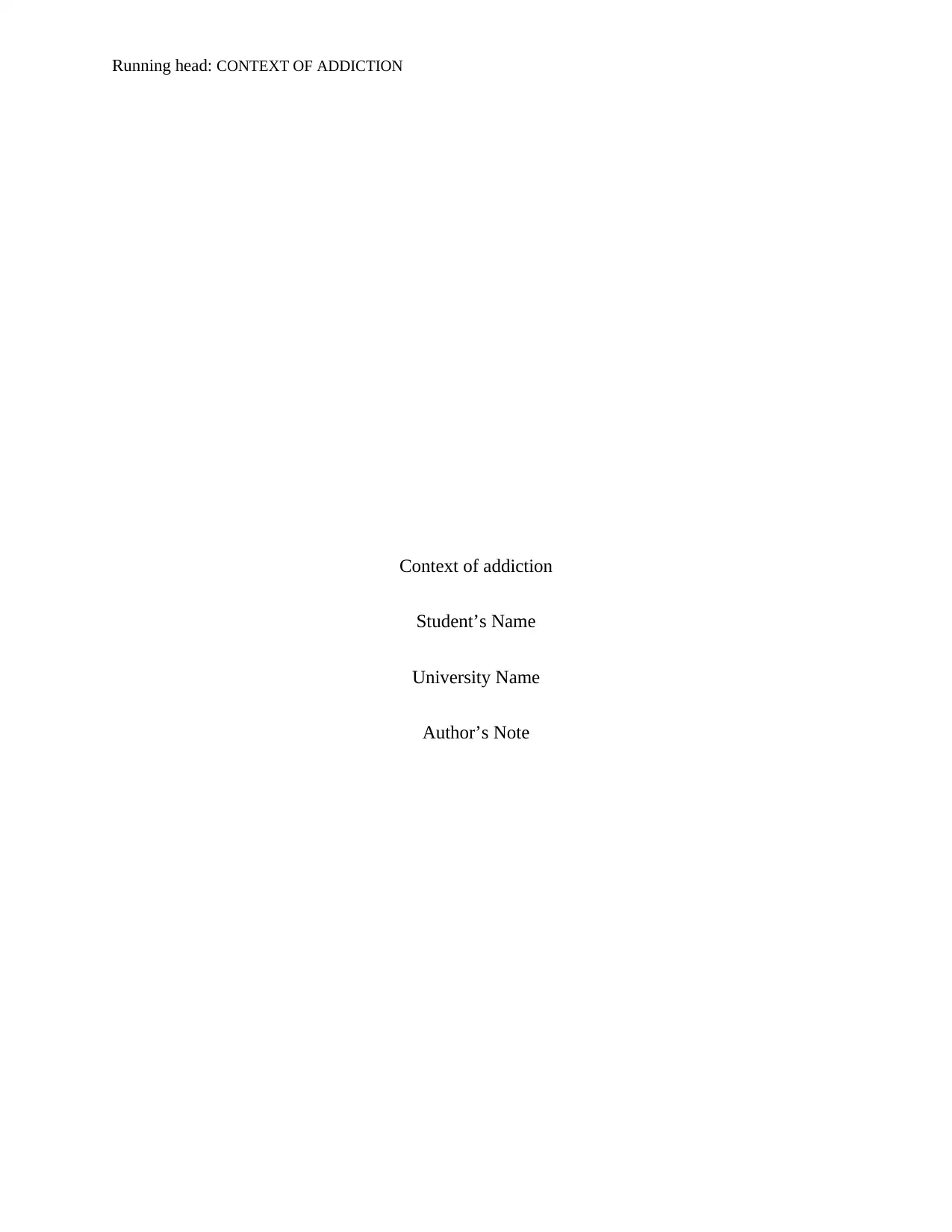
Running head: CONTEXT OF ADDICTION
Context of addiction
Student’s Name
University Name
Author’s Note
Context of addiction
Student’s Name
University Name
Author’s Note
Paraphrase This Document
Need a fresh take? Get an instant paraphrase of this document with our AI Paraphraser
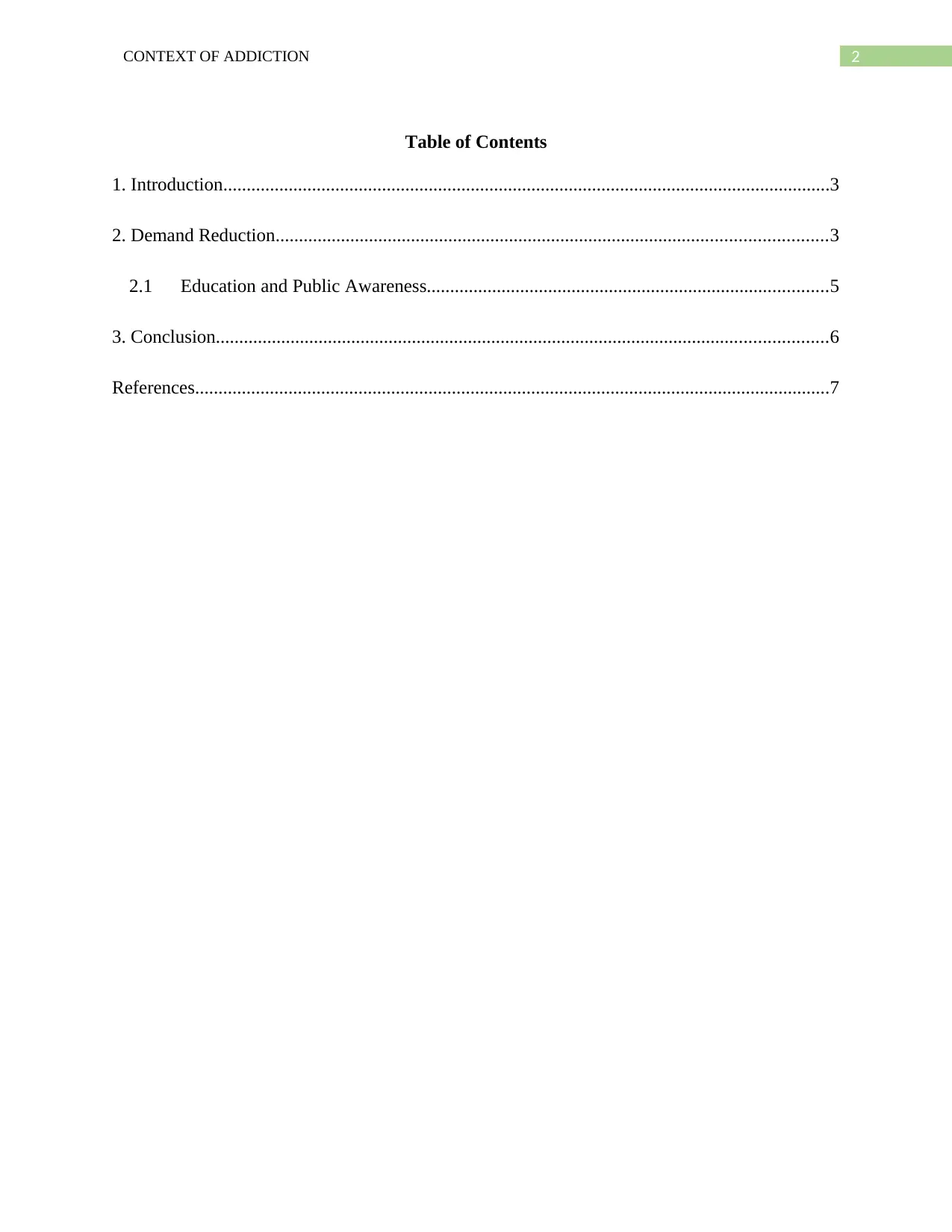
2CONTEXT OF ADDICTION
Table of Contents
1. Introduction..................................................................................................................................3
2. Demand Reduction......................................................................................................................3
2.1 Education and Public Awareness......................................................................................5
3. Conclusion...................................................................................................................................6
References........................................................................................................................................7
Table of Contents
1. Introduction..................................................................................................................................3
2. Demand Reduction......................................................................................................................3
2.1 Education and Public Awareness......................................................................................5
3. Conclusion...................................................................................................................................6
References........................................................................................................................................7
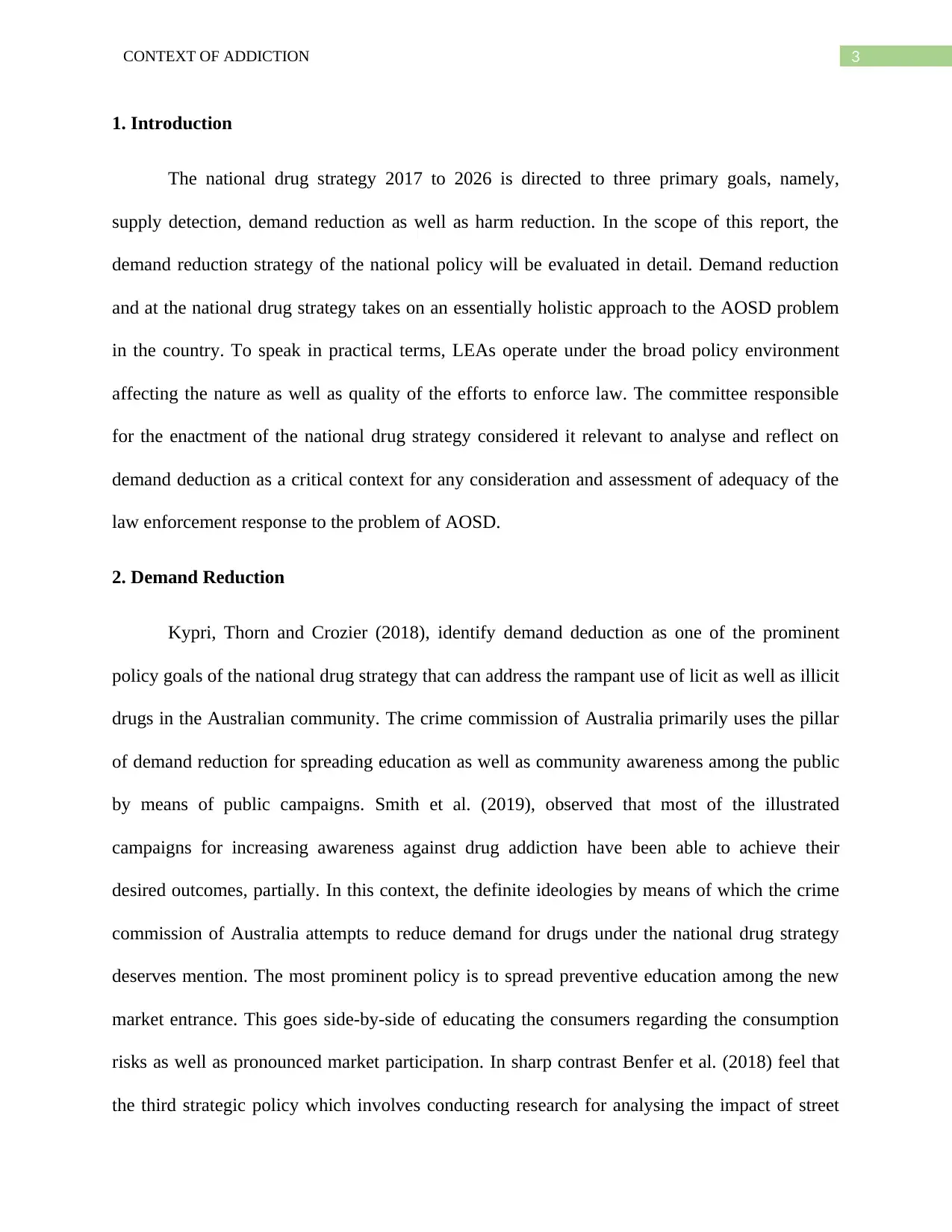
3CONTEXT OF ADDICTION
1. Introduction
The national drug strategy 2017 to 2026 is directed to three primary goals, namely,
supply detection, demand reduction as well as harm reduction. In the scope of this report, the
demand reduction strategy of the national policy will be evaluated in detail. Demand reduction
and at the national drug strategy takes on an essentially holistic approach to the AOSD problem
in the country. To speak in practical terms, LEAs operate under the broad policy environment
affecting the nature as well as quality of the efforts to enforce law. The committee responsible
for the enactment of the national drug strategy considered it relevant to analyse and reflect on
demand deduction as a critical context for any consideration and assessment of adequacy of the
law enforcement response to the problem of AOSD.
2. Demand Reduction
Kypri, Thorn and Crozier (2018), identify demand deduction as one of the prominent
policy goals of the national drug strategy that can address the rampant use of licit as well as illicit
drugs in the Australian community. The crime commission of Australia primarily uses the pillar
of demand reduction for spreading education as well as community awareness among the public
by means of public campaigns. Smith et al. (2019), observed that most of the illustrated
campaigns for increasing awareness against drug addiction have been able to achieve their
desired outcomes, partially. In this context, the definite ideologies by means of which the crime
commission of Australia attempts to reduce demand for drugs under the national drug strategy
deserves mention. The most prominent policy is to spread preventive education among the new
market entrance. This goes side-by-side of educating the consumers regarding the consumption
risks as well as pronounced market participation. In sharp contrast Benfer et al. (2018) feel that
the third strategic policy which involves conducting research for analysing the impact of street
1. Introduction
The national drug strategy 2017 to 2026 is directed to three primary goals, namely,
supply detection, demand reduction as well as harm reduction. In the scope of this report, the
demand reduction strategy of the national policy will be evaluated in detail. Demand reduction
and at the national drug strategy takes on an essentially holistic approach to the AOSD problem
in the country. To speak in practical terms, LEAs operate under the broad policy environment
affecting the nature as well as quality of the efforts to enforce law. The committee responsible
for the enactment of the national drug strategy considered it relevant to analyse and reflect on
demand deduction as a critical context for any consideration and assessment of adequacy of the
law enforcement response to the problem of AOSD.
2. Demand Reduction
Kypri, Thorn and Crozier (2018), identify demand deduction as one of the prominent
policy goals of the national drug strategy that can address the rampant use of licit as well as illicit
drugs in the Australian community. The crime commission of Australia primarily uses the pillar
of demand reduction for spreading education as well as community awareness among the public
by means of public campaigns. Smith et al. (2019), observed that most of the illustrated
campaigns for increasing awareness against drug addiction have been able to achieve their
desired outcomes, partially. In this context, the definite ideologies by means of which the crime
commission of Australia attempts to reduce demand for drugs under the national drug strategy
deserves mention. The most prominent policy is to spread preventive education among the new
market entrance. This goes side-by-side of educating the consumers regarding the consumption
risks as well as pronounced market participation. In sharp contrast Benfer et al. (2018) feel that
the third strategic policy which involves conducting research for analysing the impact of street
⊘ This is a preview!⊘
Do you want full access?
Subscribe today to unlock all pages.

Trusted by 1+ million students worldwide
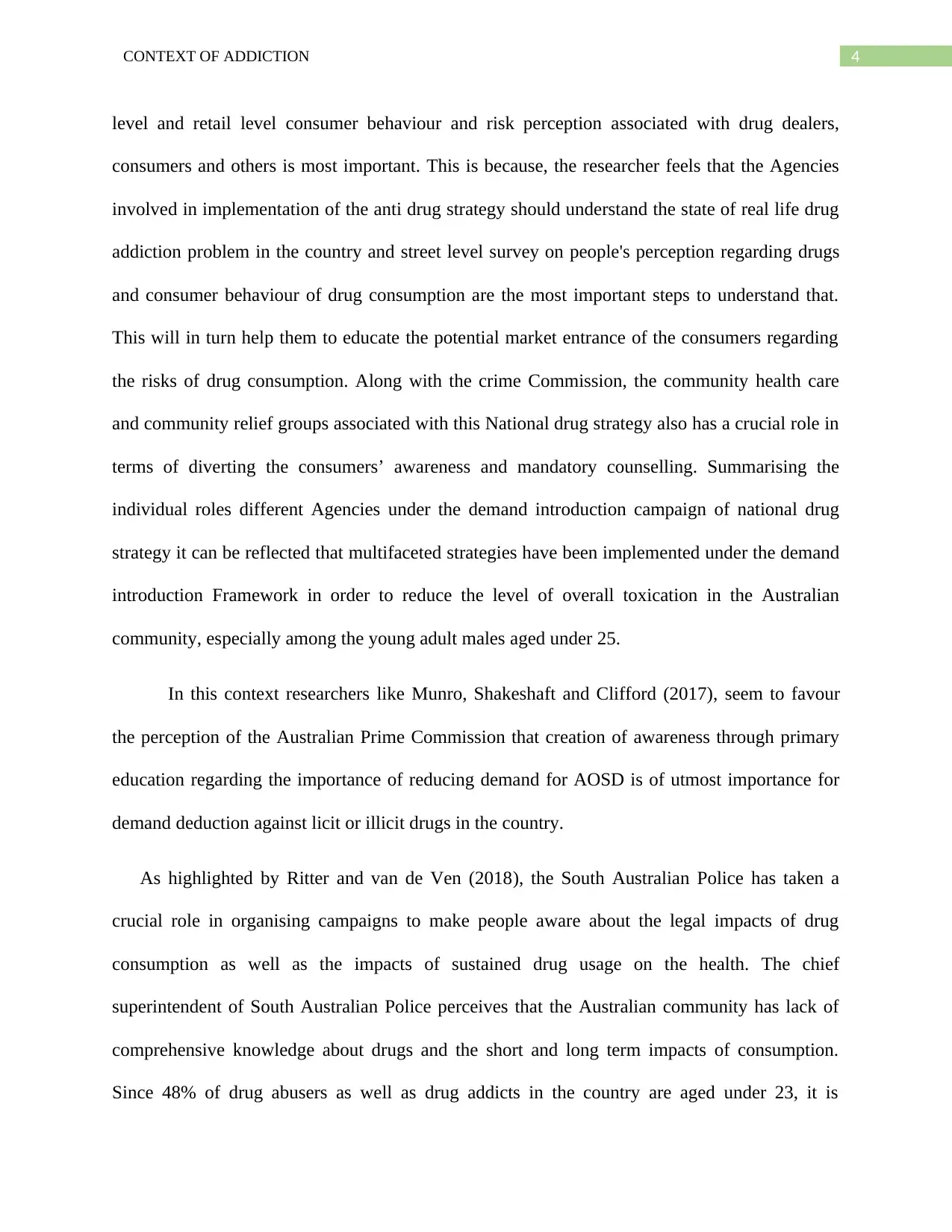
4CONTEXT OF ADDICTION
level and retail level consumer behaviour and risk perception associated with drug dealers,
consumers and others is most important. This is because, the researcher feels that the Agencies
involved in implementation of the anti drug strategy should understand the state of real life drug
addiction problem in the country and street level survey on people's perception regarding drugs
and consumer behaviour of drug consumption are the most important steps to understand that.
This will in turn help them to educate the potential market entrance of the consumers regarding
the risks of drug consumption. Along with the crime Commission, the community health care
and community relief groups associated with this National drug strategy also has a crucial role in
terms of diverting the consumers’ awareness and mandatory counselling. Summarising the
individual roles different Agencies under the demand introduction campaign of national drug
strategy it can be reflected that multifaceted strategies have been implemented under the demand
introduction Framework in order to reduce the level of overall toxication in the Australian
community, especially among the young adult males aged under 25.
In this context researchers like Munro, Shakeshaft and Clifford (2017), seem to favour
the perception of the Australian Prime Commission that creation of awareness through primary
education regarding the importance of reducing demand for AOSD is of utmost importance for
demand deduction against licit or illicit drugs in the country.
As highlighted by Ritter and van de Ven (2018), the South Australian Police has taken a
crucial role in organising campaigns to make people aware about the legal impacts of drug
consumption as well as the impacts of sustained drug usage on the health. The chief
superintendent of South Australian Police perceives that the Australian community has lack of
comprehensive knowledge about drugs and the short and long term impacts of consumption.
Since 48% of drug abusers as well as drug addicts in the country are aged under 23, it is
level and retail level consumer behaviour and risk perception associated with drug dealers,
consumers and others is most important. This is because, the researcher feels that the Agencies
involved in implementation of the anti drug strategy should understand the state of real life drug
addiction problem in the country and street level survey on people's perception regarding drugs
and consumer behaviour of drug consumption are the most important steps to understand that.
This will in turn help them to educate the potential market entrance of the consumers regarding
the risks of drug consumption. Along with the crime Commission, the community health care
and community relief groups associated with this National drug strategy also has a crucial role in
terms of diverting the consumers’ awareness and mandatory counselling. Summarising the
individual roles different Agencies under the demand introduction campaign of national drug
strategy it can be reflected that multifaceted strategies have been implemented under the demand
introduction Framework in order to reduce the level of overall toxication in the Australian
community, especially among the young adult males aged under 25.
In this context researchers like Munro, Shakeshaft and Clifford (2017), seem to favour
the perception of the Australian Prime Commission that creation of awareness through primary
education regarding the importance of reducing demand for AOSD is of utmost importance for
demand deduction against licit or illicit drugs in the country.
As highlighted by Ritter and van de Ven (2018), the South Australian Police has taken a
crucial role in organising campaigns to make people aware about the legal impacts of drug
consumption as well as the impacts of sustained drug usage on the health. The chief
superintendent of South Australian Police perceives that the Australian community has lack of
comprehensive knowledge about drugs and the short and long term impacts of consumption.
Since 48% of drug abusers as well as drug addicts in the country are aged under 23, it is
Paraphrase This Document
Need a fresh take? Get an instant paraphrase of this document with our AI Paraphraser
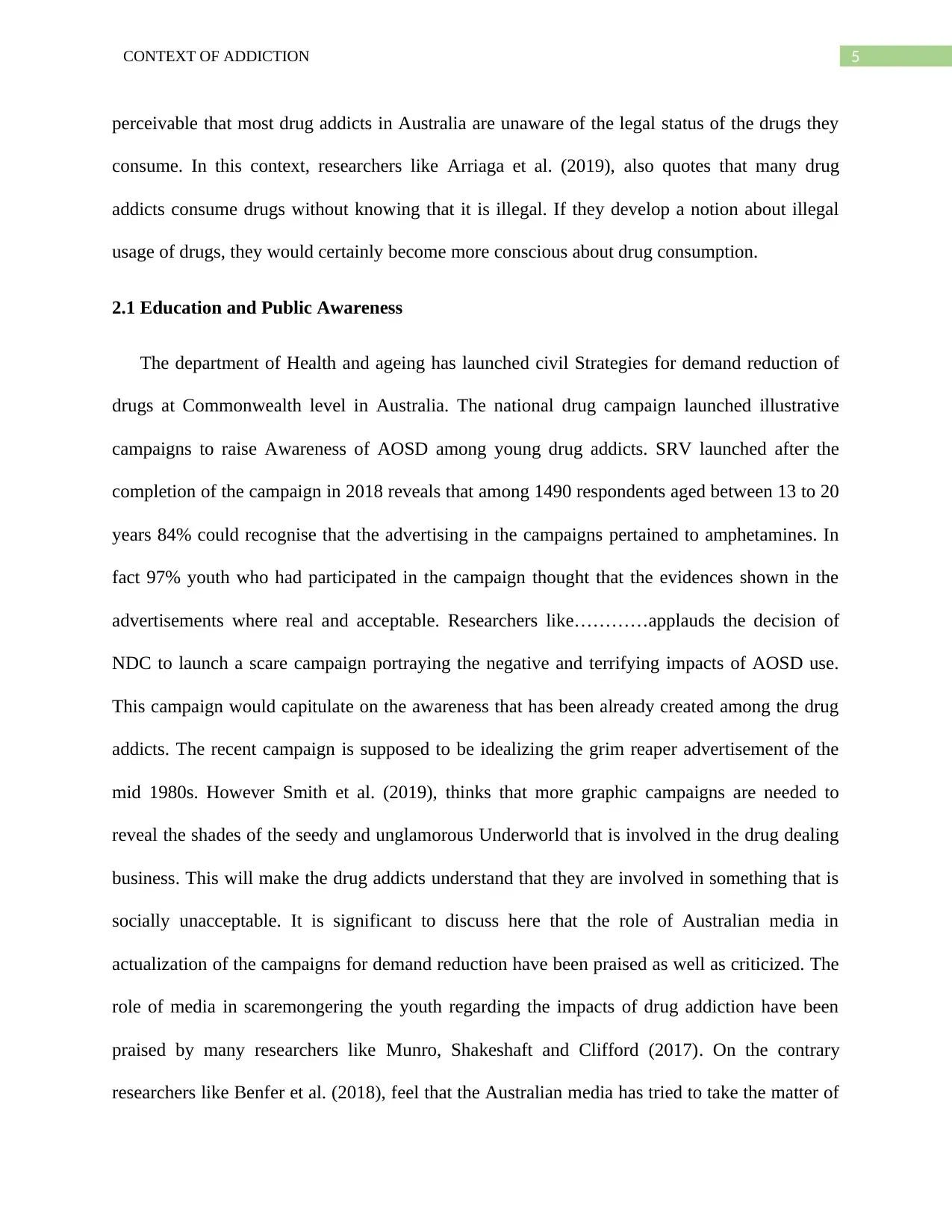
5CONTEXT OF ADDICTION
perceivable that most drug addicts in Australia are unaware of the legal status of the drugs they
consume. In this context, researchers like Arriaga et al. (2019), also quotes that many drug
addicts consume drugs without knowing that it is illegal. If they develop a notion about illegal
usage of drugs, they would certainly become more conscious about drug consumption.
2.1 Education and Public Awareness
The department of Health and ageing has launched civil Strategies for demand reduction of
drugs at Commonwealth level in Australia. The national drug campaign launched illustrative
campaigns to raise Awareness of AOSD among young drug addicts. SRV launched after the
completion of the campaign in 2018 reveals that among 1490 respondents aged between 13 to 20
years 84% could recognise that the advertising in the campaigns pertained to amphetamines. In
fact 97% youth who had participated in the campaign thought that the evidences shown in the
advertisements where real and acceptable. Researchers like…………applauds the decision of
NDC to launch a scare campaign portraying the negative and terrifying impacts of AOSD use.
This campaign would capitulate on the awareness that has been already created among the drug
addicts. The recent campaign is supposed to be idealizing the grim reaper advertisement of the
mid 1980s. However Smith et al. (2019), thinks that more graphic campaigns are needed to
reveal the shades of the seedy and unglamorous Underworld that is involved in the drug dealing
business. This will make the drug addicts understand that they are involved in something that is
socially unacceptable. It is significant to discuss here that the role of Australian media in
actualization of the campaigns for demand reduction have been praised as well as criticized. The
role of media in scaremongering the youth regarding the impacts of drug addiction have been
praised by many researchers like Munro, Shakeshaft and Clifford (2017). On the contrary
researchers like Benfer et al. (2018), feel that the Australian media has tried to take the matter of
perceivable that most drug addicts in Australia are unaware of the legal status of the drugs they
consume. In this context, researchers like Arriaga et al. (2019), also quotes that many drug
addicts consume drugs without knowing that it is illegal. If they develop a notion about illegal
usage of drugs, they would certainly become more conscious about drug consumption.
2.1 Education and Public Awareness
The department of Health and ageing has launched civil Strategies for demand reduction of
drugs at Commonwealth level in Australia. The national drug campaign launched illustrative
campaigns to raise Awareness of AOSD among young drug addicts. SRV launched after the
completion of the campaign in 2018 reveals that among 1490 respondents aged between 13 to 20
years 84% could recognise that the advertising in the campaigns pertained to amphetamines. In
fact 97% youth who had participated in the campaign thought that the evidences shown in the
advertisements where real and acceptable. Researchers like…………applauds the decision of
NDC to launch a scare campaign portraying the negative and terrifying impacts of AOSD use.
This campaign would capitulate on the awareness that has been already created among the drug
addicts. The recent campaign is supposed to be idealizing the grim reaper advertisement of the
mid 1980s. However Smith et al. (2019), thinks that more graphic campaigns are needed to
reveal the shades of the seedy and unglamorous Underworld that is involved in the drug dealing
business. This will make the drug addicts understand that they are involved in something that is
socially unacceptable. It is significant to discuss here that the role of Australian media in
actualization of the campaigns for demand reduction have been praised as well as criticized. The
role of media in scaremongering the youth regarding the impacts of drug addiction have been
praised by many researchers like Munro, Shakeshaft and Clifford (2017). On the contrary
researchers like Benfer et al. (2018), feel that the Australian media has tried to take the matter of
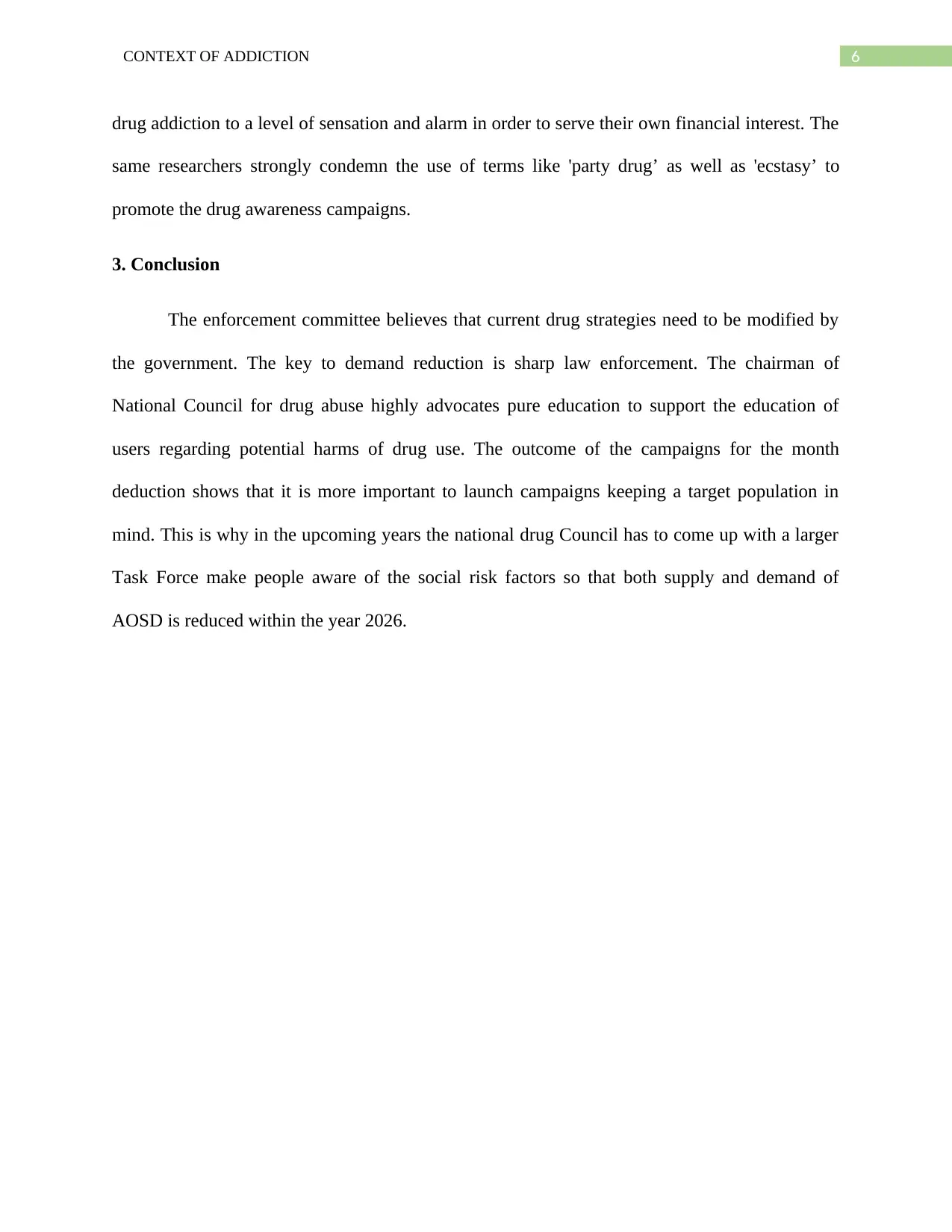
6CONTEXT OF ADDICTION
drug addiction to a level of sensation and alarm in order to serve their own financial interest. The
same researchers strongly condemn the use of terms like 'party drug’ as well as 'ecstasy’ to
promote the drug awareness campaigns.
3. Conclusion
The enforcement committee believes that current drug strategies need to be modified by
the government. The key to demand reduction is sharp law enforcement. The chairman of
National Council for drug abuse highly advocates pure education to support the education of
users regarding potential harms of drug use. The outcome of the campaigns for the month
deduction shows that it is more important to launch campaigns keeping a target population in
mind. This is why in the upcoming years the national drug Council has to come up with a larger
Task Force make people aware of the social risk factors so that both supply and demand of
AOSD is reduced within the year 2026.
drug addiction to a level of sensation and alarm in order to serve their own financial interest. The
same researchers strongly condemn the use of terms like 'party drug’ as well as 'ecstasy’ to
promote the drug awareness campaigns.
3. Conclusion
The enforcement committee believes that current drug strategies need to be modified by
the government. The key to demand reduction is sharp law enforcement. The chairman of
National Council for drug abuse highly advocates pure education to support the education of
users regarding potential harms of drug use. The outcome of the campaigns for the month
deduction shows that it is more important to launch campaigns keeping a target population in
mind. This is why in the upcoming years the national drug Council has to come up with a larger
Task Force make people aware of the social risk factors so that both supply and demand of
AOSD is reduced within the year 2026.
⊘ This is a preview!⊘
Do you want full access?
Subscribe today to unlock all pages.

Trusted by 1+ million students worldwide
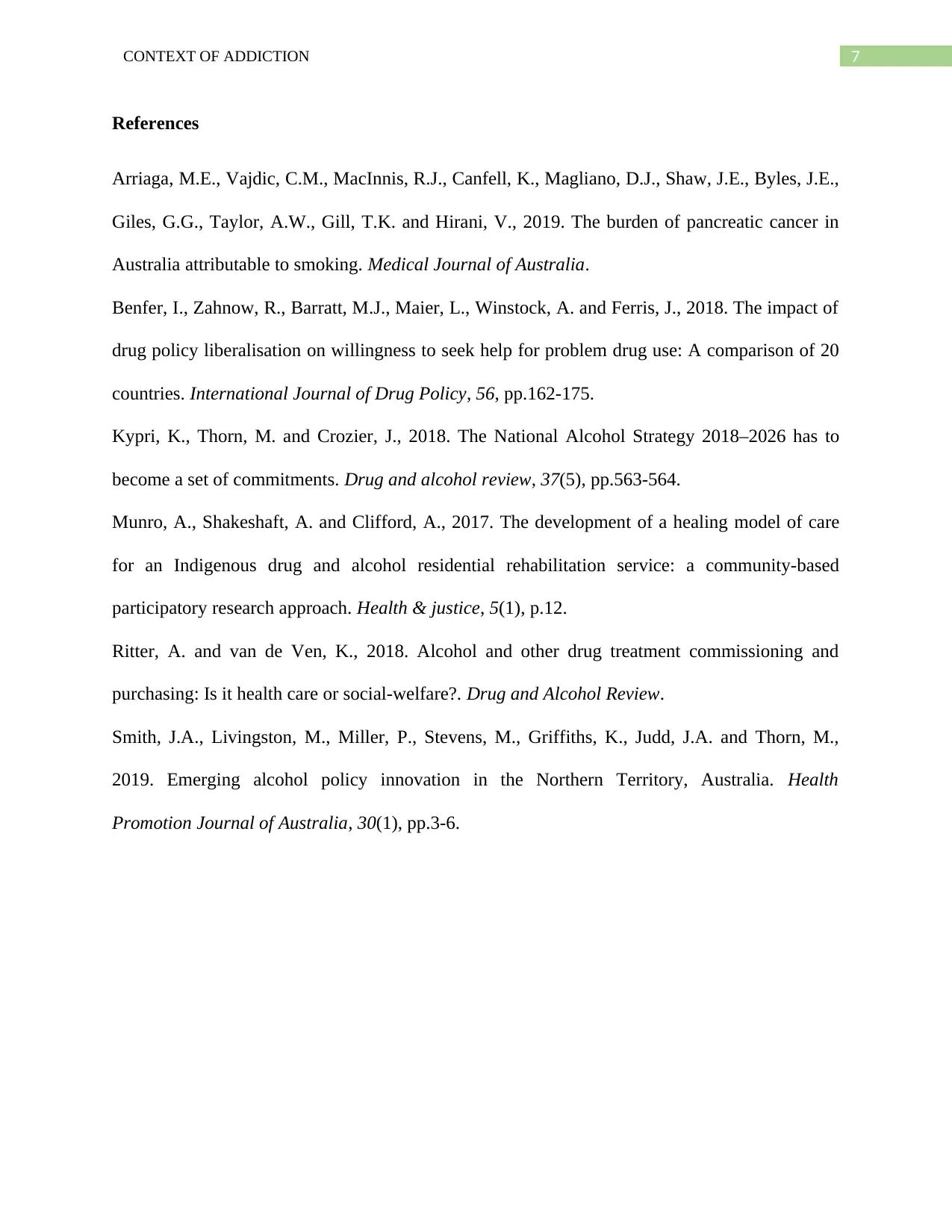
7CONTEXT OF ADDICTION
References
Arriaga, M.E., Vajdic, C.M., MacInnis, R.J., Canfell, K., Magliano, D.J., Shaw, J.E., Byles, J.E.,
Giles, G.G., Taylor, A.W., Gill, T.K. and Hirani, V., 2019. The burden of pancreatic cancer in
Australia attributable to smoking. Medical Journal of Australia.
Benfer, I., Zahnow, R., Barratt, M.J., Maier, L., Winstock, A. and Ferris, J., 2018. The impact of
drug policy liberalisation on willingness to seek help for problem drug use: A comparison of 20
countries. International Journal of Drug Policy, 56, pp.162-175.
Kypri, K., Thorn, M. and Crozier, J., 2018. The National Alcohol Strategy 2018–2026 has to
become a set of commitments. Drug and alcohol review, 37(5), pp.563-564.
Munro, A., Shakeshaft, A. and Clifford, A., 2017. The development of a healing model of care
for an Indigenous drug and alcohol residential rehabilitation service: a community-based
participatory research approach. Health & justice, 5(1), p.12.
Ritter, A. and van de Ven, K., 2018. Alcohol and other drug treatment commissioning and
purchasing: Is it health care or social‐welfare?. Drug and Alcohol Review.
Smith, J.A., Livingston, M., Miller, P., Stevens, M., Griffiths, K., Judd, J.A. and Thorn, M.,
2019. Emerging alcohol policy innovation in the Northern Territory, Australia. Health
Promotion Journal of Australia, 30(1), pp.3-6.
References
Arriaga, M.E., Vajdic, C.M., MacInnis, R.J., Canfell, K., Magliano, D.J., Shaw, J.E., Byles, J.E.,
Giles, G.G., Taylor, A.W., Gill, T.K. and Hirani, V., 2019. The burden of pancreatic cancer in
Australia attributable to smoking. Medical Journal of Australia.
Benfer, I., Zahnow, R., Barratt, M.J., Maier, L., Winstock, A. and Ferris, J., 2018. The impact of
drug policy liberalisation on willingness to seek help for problem drug use: A comparison of 20
countries. International Journal of Drug Policy, 56, pp.162-175.
Kypri, K., Thorn, M. and Crozier, J., 2018. The National Alcohol Strategy 2018–2026 has to
become a set of commitments. Drug and alcohol review, 37(5), pp.563-564.
Munro, A., Shakeshaft, A. and Clifford, A., 2017. The development of a healing model of care
for an Indigenous drug and alcohol residential rehabilitation service: a community-based
participatory research approach. Health & justice, 5(1), p.12.
Ritter, A. and van de Ven, K., 2018. Alcohol and other drug treatment commissioning and
purchasing: Is it health care or social‐welfare?. Drug and Alcohol Review.
Smith, J.A., Livingston, M., Miller, P., Stevens, M., Griffiths, K., Judd, J.A. and Thorn, M.,
2019. Emerging alcohol policy innovation in the Northern Territory, Australia. Health
Promotion Journal of Australia, 30(1), pp.3-6.
1 out of 7
Related Documents
Your All-in-One AI-Powered Toolkit for Academic Success.
+13062052269
info@desklib.com
Available 24*7 on WhatsApp / Email
![[object Object]](/_next/static/media/star-bottom.7253800d.svg)
Unlock your academic potential
Copyright © 2020–2025 A2Z Services. All Rights Reserved. Developed and managed by ZUCOL.




